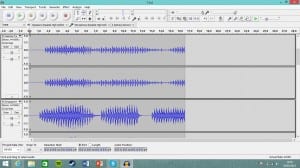To create art is to creatively interpret and respond to a stimulus. Transmedial response is one way of transferring an idea between media forms. This is a good way to help develop an idea because it allows you to translate it into different forms that allow you to see find different understandings from different points of view.
I created a transmedia interpretation of a drawing of the iron girders. I decided to interpret this into a sound collage.
This sound collage represents the industrial history of the building. This is interesting because although the Library has changed a lot since is was used for industrial purposes, the structural skeleton of the building has remained the same. When redesigning the library the architects left these ‘raw’ parts of the building to add character and to insure that the buildings history is not lost.
Influence
This exercise helped in the development of my groups site specific performance. We decided to interpret and present our interpretation of the site through different forms instead of sticking to the generic conventions of a performance. We have focused our ideas more on the performativity of the body and the architecture, represented mainly through anatomical sculptures.
